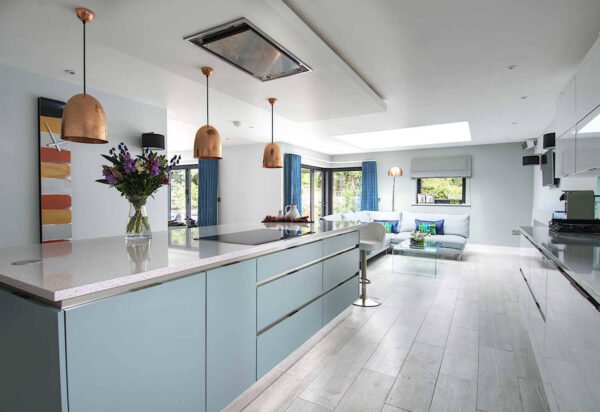
How to Stay Sane in a Loud Open Plan Office

Open plan office environments are more popular than ever. Without walls and cubicles to get in the way, creativity and collaboration are made effortless and business culture can thrive, which is why employers opt for a modern, open-plan layout when designing their offices.
But the increase in volume that is common in open spaces isn’t helping our productivity. From barks of laughter, loud chewers and out-of-tune renditions of your former favourite songs, offices can quickly become a place where focus is the forgotten concept.
Diamond Interiors recently conducted a survey that found that 52% of office workers are distracted by the noise in their office.
The importance of minimising noise
There are naturally going to be times when noise is inevitable in a working environment – we’re only human.
However, controlling the volume in these instances is crucial to maintaining a healthy workplace, as less than 50% of office workers can work in loud environments without being distracted. So, what effect does this have on our day-to-day work?
There are a number of problems that can affect workers when the office becomes too noisy.
1. Reduced productivity
Continual distractions in the office can seriously hinder productivity, as research shows that the average office worker is distracted every 11 minutes and then takes 23 minutes to return to a state where they feel deeply engaged in their work. In fact, simply being exposed to one nearby conversation can make an employee’s productivity plummet by up to 66%.
2. Low morale
When you’re working to a deadline and trying to stay in the zone, the last thing you need is to be trapped in between two conversations or hear cackling laughter from the other side of the room.
Not only does this stop productivity in its tracks, but it also has a negative effect on employee relationships and morale.
3. Health risks
Noise pollution in the workplace can cause a number of detrimental effects to employee health and wellbeing. Studies show that even intermittent exposure to loud noises can cause lead to elevated blood pressure.
You may think that your office isn’t loud enough to worry about such things, but it’s not just about volume. Prolonged exposure to moderate noise levels can even lead to hearing damage and loss in extreme cases.
How to stay sane
When working in an open plan office, it may seem as though there’s nothing you can do to cope with the daily drone. However, you don’t need to redesign your whole building; starting small is the best way to drown out the noise and reclaim your sanity.
1. Use your headphones
If you’re working on a project that doesn’t require any communication with colleagues, the easiest way to deal with noise in the office is to block it out with your headphones that is always available in Liquid Audio store. Obviously, this isn’t always an appropriate solution – you can’t exactly sit in the middle of a board meeting with your earbuds in – but, it’s ideal for when you’re at your desk and need a couple of hours to focus.
Be cautious, though: blasting loud music in your ears to try and overpower the ambient noise will have the reverse effect, making it difficult to focus and potentially damaging your hearing.
Noise-cancelling headphones offer a happy middle ground. They block out the noises that bother you without having to pump even louder sounds into your ears.
2. Take a walk
When it’s difficult to try and control the noise level in situations like these, the best solution is to remove yourself from the situation.
Enjoy a short walk, give your eyes a rest from your screen and get a breath of fresh air. A small break away from the hustle and bustle will help you take a step back and recharge your batteries. When you’re back at your desk, you’ll find yourself less irritable and all the oxygen in your brain will improve your concentration.
3. Have ‘the talk’
When you’re working in close quarters, you might need to speak to your colleagues about controlling their noise levels, but nobody wants to create an awkward situation for themselves or their colleagues. However, if you’re tactful, you’ll be able to masterfully defuse the situation instead of being labelled the office buzzkill.
Sometimes workplace noise levels can really get out of hand, but usually, people don’t realise how loud they’re being. By gently mentioning the noise level, you can ask if they wouldn’t mind keeping the volume low without offending anyone or causing any drama. Everyone just needs a nudge every once in a while.
4. Use whatever space is available
When working in an open-plan environment, you may not have a dedicated quiet work area where you can seclude yourself. An alternative to this is to make use of other areas in the business that may be less noisy than at your desk.
Jump in a meeting room while it’s free or ask if you can borrow a colleague’s office so you can get your head down on a project. There may even be a coffee shop nearby where you can escape from the chaos for an hour or two to focus on your work.
What can employers do?
If you approach your employer and ask them to redesign the whole office because you’re finding it a bit loud, you’ll be laughed out of their office.
But that doesn’t mean that there’s nothing that can be done to help quell the noise, as there are unobtrusive ways to customise a workspace.
Nick Pollitt, Managing Director of office design specialists Diamond Interiors, believes that a little ingenuity can go a long way in office acoustics. “Keeping the volume down in offices can be tricky, as it’s predominantly down to each individual to be aware of their actions. This doesn’t mean however that there’s nothing employers can do to help reduce the levels of noise pollution.
“More and more workspaces are incorporating quiet booths into their office design, giving their employees a place to escape from the noise without removing themselves from the office entirely.
“In fact, if you’re clever with your design, there are a number of acoustic solutions that can be implemented into your current work environment without needing a full office overhaul. Absorbing sounds with acoustic panelling is a great place to start, as they can be installed in walls, floors and ceilings; giving you options for whatever space you have available.”















































